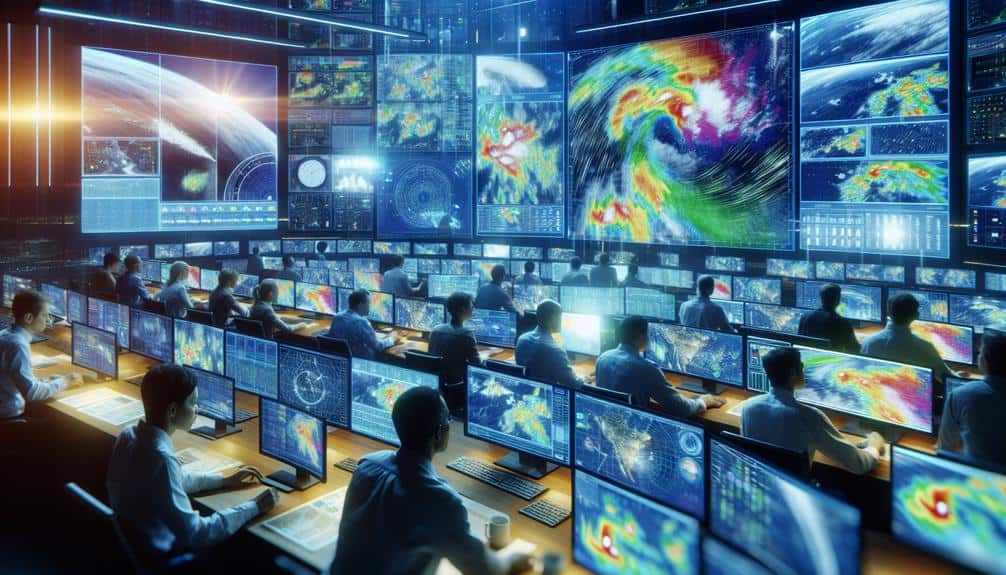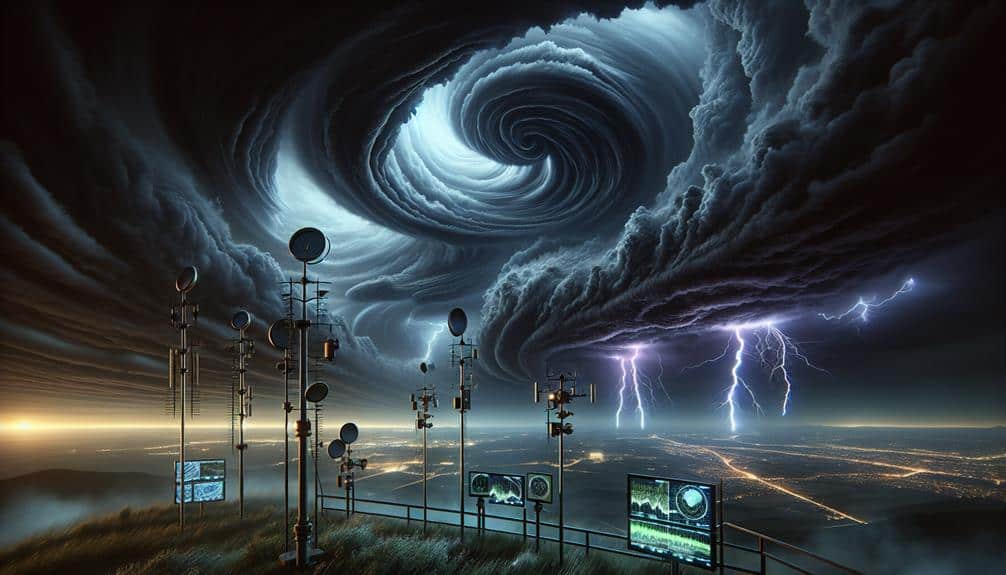We rely on three primary techniques to spot storm formations early. High-resolution satellite imagery captures detailed views of atmospheric conditions, using advanced algorithms and machine learning to process data across multiple spectral bands. Doppler radar interpretation provides precise measurements of storm velocity and precipitation intensity, highlighting radial velocity patterns and precipitation reflectivity. Additionally, cloud pattern recognition identifies specific formations like cumulonimbus clouds for thunderstorms and mammatus clouds indicating severe turbulence. Together, these methods enhance our ability to predict and prepare for severe weather. For those keen to gain deeper insights, there's so much more to explore in storm detection technology.
Key Points
- High-resolution satellite imagery detects early storm formation signs through detailed atmospheric condition views.
- Doppler radar measures storm velocity and precipitation intensity, identifying severe weather systems.
- Cloud pattern recognition, including cumulonimbus and mammatus clouds, signals potential severe thunderstorms.
- Satellite sensors capture multi-spectral data, enhancing storm detection and weather prediction models.
Satellite Imagery Analysis
By leveraging high-resolution satellite imagery, we can detect early signs of storm formations with remarkable accuracy. This capability is critical for enhancing weather prediction models, allowing us to anticipate severe weather events and take necessary precautions. High-resolution imagery offers detailed views of atmospheric conditions, such as cloud cover, temperature gradients, and moisture levels. These elements are essential for identifying the early stages of storm development.
Satellite sensors capture data across multiple spectral bands, providing insights into both visible and infrared wavelengths. By analyzing this data, we can discern patterns and anomalies that indicate potential storm formations. For instance, infrared imagery helps us track temperature variations within cloud tops, which can signal the intensification of storm systems. Visible light imagery, on the other hand, aids in observing cloud structures and movements.
We utilize advanced algorithms and machine learning techniques to process the vast amounts of data collected. These tools enable us to detect subtle changes in atmospheric conditions that might go unnoticed by traditional methods. The integration of satellite imagery into our weather prediction systems greatly enhances our ability to forecast storms, ensuring we have the freedom to prepare and respond effectively.
Doppler Radar Interpretation
Doppler radar plays a critical role in meteorology by providing precise measurements of storm velocity and precipitation intensity, enabling us to interpret storm dynamics in real-time. By analyzing the shift in frequency of returned radar signals, we can determine the motion of raindrops within a storm, which is pivotal for accurate weather prediction and storm tracking.
Utilizing Doppler radar, we can observe radial velocity patterns that indicate rotation within a storm system. This rotational data is essential for identifying mesocyclones, which are often precursors to tornado formation. For instance, a strong, tight couplet of inbound and outbound velocities on the radar display signifies a high likelihood of tornadic activity. By continuously monitoring these radar signatures, we can issue timely warnings, maximizing public safety.
Additionally, Doppler radar's capability to measure reflectivity informs us about precipitation intensity. High reflectivity values typically correspond to heavy rainfall, hail, or severe thunderstorms. Integrating this data with velocity measurements allows us to construct a detailed view of storm structures. This dual-analysis approach enhances our ability to forecast storm progression and potential impacts, empowering individuals to make informed decisions and embrace their freedom without compromising safety.
Cloud Pattern Recognition
Analyzing cloud formations, we can further enhance our storm detection capabilities by recognizing specific patterns that often precede severe weather events. By coupling cloud pattern recognition with weather app usage and storm tracking, we gain a thorough approach to early detection.
Firstly, let's look at the types of cloud patterns that indicate potential storms:
- Cumulonimbus Clouds: These towering, dense clouds often signify severe thunderstorms. Their rapid vertical growth can be correlated with high moisture levels and unstable atmospheric conditions.
- Mammatus Clouds: Characterized by their pouch-like structures, these clouds indicate intense turbulence and can precede severe weather, including tornadoes.
- Shelf Clouds: These low, horizontal clouds are often seen at the leading edge of a thunderstorm and signal strong gust fronts and wind direction changes.
Integrating cloud pattern recognition with real-time wind direction observations and moisture level assessments enhances our predictive accuracy. For instance, identifying a cumulonimbus cloud formation can trigger alerts in weather apps, aligning with wind direction data to refine storm tracking models.
Frequently Asked Questions
How Does Atmospheric Pressure Influence Storm Development?
Atmospheric pressure influences storm development by interacting with temperature gradients and humidity levels. Low pressure areas create conditions where warm, moist air rises, cools, and condenses, leading to cloud formation and potential storms.
What Role Do Sea Surface Temperatures Play in Storm Formation?
Sea surface temperatures greatly impact storm formation. Higher temperatures, influenced by ocean currents, provide energy for storm development. This impact of climate change leads to more frequent and intense storms, affecting our freedom and safety.
Can Early Storm Spotting Be Done Without Advanced Technology?
Studies show 80% of early storm detections rely on visual observations and cloud patterns. We can achieve early warning through natural signs like cloud formations and wind shifts, even without advanced technology. It empowers us to predict storms independently.
How Do Wind Shear Conditions Affect Storm Formation?
Wind shear effects can greatly impact storm formation by either enhancing or inhibiting storm development. We must analyze wind shear's vertical and horizontal components to understand its precise role in shaping storm dynamics and intensity.
What Are Common Signs of Storm Formation Visible to the Naked Eye?
Like sailors reading the stars, we watch for cloud patterns shifting, wind direction changing, lightning flashes illuminating the sky, and temperature changes warning us. These signs, data-driven indicators, guide our understanding of impending storm formations.


